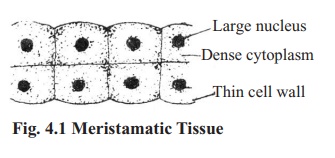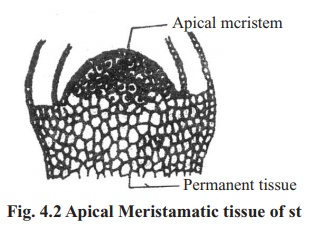Chapter: Biology: Division of Labour In Multicellular Plants : Tissue and Tissue System
Types of Tissue
Tissue :
In unicellular organisms a single cell does all the functions. There is no chance of division of labour on the basis of cell. In contrast, this kind of division is found in multicellular living body. In this case, it is observed that a group of cells performs the duty of manufacturing food; another group stores it, while the other group conducts the transport of food materials. There is further a group of cells that gives mechanical strenght to some organs. In many cases it is observed that a group of cells originating from a single origin remain closely attached in a place and collectively perform a similar type of function. This type of cells in a group is called tissue. In multicellular organisms division of labour is the main cause of formation of tissue.
Types of Tissue :
Cells of all tissues do not have the power of cell division but some of them have. Therefore tissues are of two types in terms of the power of cell division :
1. Meristamatic tissue &
2. Permanent tissue
1. Meristamatic tissue : Meristamaticcells compose the Meristamatic tissue. The cells of this tissue divide repeatedly. These tissues are found in the tress. Due to their presence plants increase in size very rapidly. Other permanent tissues are originated from Meristamatic tissue.


Characrteristics of Meristamatic tissues :
Characrteristics of Meristamatic tissues are as follows :
1. Cells possess the power of cell division.
2. Usually the cells are rectangular of oval.
3. Cell wall is made of cellulose and is thin.
4. Nucleus is large and the cytoplasm is denser.
5. Usually no vacuole is seen in the cell.
6. Usually there is no intercellular space in Meristamatic tissue, so the cells are arranged compactly.
Meristamatic tissues are present at the apex of roots and stems. According to their position they are Apical meristems and accroding to their origin they are Primary meristems, because they are originated from the embryonic stage.Stem and root increase in length by the division of cells of these tissues.
In the roots and stems of gymnosperms and dicotyledonous plants there develops a new Meristamatic tissue, they are called 'Secondary meristems. According to their position they are Secondary meristems. Due to the cell division of these tissues the breath of the root and stem increase i.e. the root and stem gradually become broader in breath
2. Permanent tissue:
Cells of permanent tissues are not capable of cell division, for which they are called Permanent tissue. They are originated from Meristamatic tissues. All tissues other than the Meristamatic ones are permanent tissues.


Characteristics of Permanent tissue:
1. Cells of these tissues have no power of division.
2. Cells are well developed and properly shaped.
3. Cell wall is comparatively thick.
4. Nucleus of the cells are bigger and cytoplasm is dense.
5. Usually there are vacuoles in the cell.
6. There may have intercellular spaces in between cells.
Related Topics